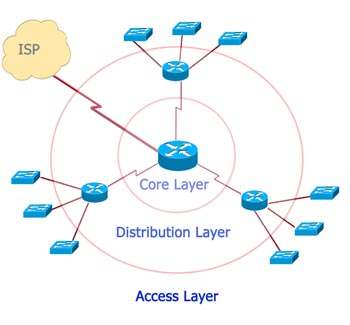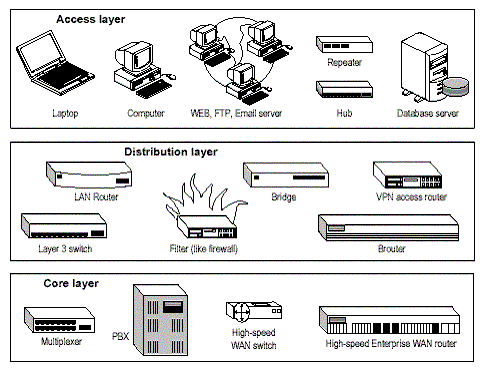Starting with the basics, the Cisco network is traditionally defined as a three-tier hierarchical model comprising the core, distribution, and access layers. Cisco both developed their system according to this model and recommend their end-users to follow the same philosophy. Cisco’s three-layered model is a widely used network model, besides the OSI Layered Model and TCP/IP Layered Model. Cisco also highlighted the importance of the Cisco three-layered model in its famous CCNA certifications.
Hierarchical network design helps us to make networks more reliable and predictable. Level by level design help to understand networking factions easily like, we can use tools like access lists at specific level and can avoid them from others.
Cisco layer model consist of the following three layers.
• The Core layer
• The Distribution layer
• The Access layer
Each layer plays a role and specific responsibilities are assigned to these three logical layers. These layers are same like the network layers of OSI reference model.
The seven layers in OSI model describe some functions but not protocols. One protocol is could be mapped to more than one layers and more than one protocol can communicate with one layer. In the same way, using Cisco model we can build physical implementations of using hierarchical networks implementations. We can use many devices in a single layer and we can also use single device to perform functions at two layers.
Here is the detailed explanation of these layers.
Core Layer
Core layer is known as core of network as it is on the top of the network and it is responsible to transfer heavy amount of traffic in reliable and quick manner. Objective of core layer is to speed up the network traffic as much as possible. Traffic at core layer is common for most of users and user data is transported to distribution layers which forwards requests if it is required. If core layer is affected by a failure, every user is affected on network. Fault tolerance is main thing to consider on this layer.
The main responsibility of core layer is to see heavy traffic, so speed and traffic issues are concerned at this layer. What are functions of core layer not do the following things.
• Protect the network from slowing down the traffic, use of access lists, routing between different Virtual Local Area Networks (VLANs) and Packet Filtering.
• Protect network from workgroup access support.
• Don’t expand core as network grows. Try to overcome performance issue by adding routers and prefer to upgrade devices over expansion.
However while designing core, we want to do the following things.
• Design the core by using data link technologies which provides speed and redundancy like FDDI, Fast Ethernet and ATM.
• Prefer to select protocols with low convergence time and fast redundant link connectivity.
Examples of core layer Cisco equipment include:
Cisco switches such as 7000, 7200, 7500, and 12000 (for WAN use)
Catalyst switches such as 6000, 5000, and 4000 (for LAN use)
T-1 and E-1 lines, Frame relay connections, ATM networks, Switched Multimegabit Data Service (SMDS)
Distribution Layer
It is also known as workgroup layer and it is called communication point between access and core layer. Basic function of distribution layer is routing, filtering and WAN access and find out the method by which packets can access the core. This layer must find out the fastest mechanism to handle network operations like how to handling and forwarding a file to server on request. After finding best path, distribution layer forward request towards core layer and then to the right service. Policy implementation is done on distribution layer and you can exercise flexibility defining network operations.
Here are the functions which should be done at distribution layer.
• Implementations of access lists for filtering interesting traffic and blocking uninteresting traffic.
• Security and network policy implementation containing address translation and firewalls.
• Static routing redistribution
• Enabling routing between all VLANs
• Defining broadcast and multicast domains
The Access Layer
The access layer is sometimes referred to as the desktop layer. The network resources the workgroup and users needed will be available locally.
The access layer is the edge of the entire network, where a wide variety of types of consumer devices such as PCs, printers, cameras attach to the wired portion of the network, various services are provided, and dynamic configuration mechanisms implemented. As a result, the access layer is most feature-rich layer of the Cisco three-layered model.
At the access layer, you can:
• Enable MAC address filtering: It is possible to program a switch to allow only certain systems to access the connected LANs.
• Create separate collision domains: A switch can create separate collision domains for each connected node to improve performance.
• Share bandwidth: You can allow the same network connection to handle all data.
• Handle switch bandwidth: You can move data from one network to another to perform load balancing.
DDR (Double Data Rate) and Ethernet switching technology are mainly used in access layer with Static routing.
More Cisco info:
Demo: How to Configure InterVLAN Routing On Layer 3 Switches?


